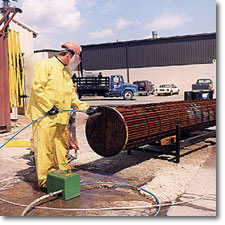High-Pressure Water Blasting & Cutting
Process Line Cleaning
National Vacuum can clean process lines, tube bundles, boiler tubes, condensers, and heat exchangers using a variety of methods, such as rigid or flexible lancing and straight “shotgunning.” Our ability to regulate water pressure and use different types of cutting nozzles enables the safe removal of scale or hardened materials from the interior of pipes—all without causing any damage.
Vessel Cleaning
National Vacuum can clean vessels using remote two- or three-dimensional rotary heads that allow for cleaning the interior of vessels without exposing personnel to dangerous situations. Cleaning can also be performed using conventional methods, which may require entry. Our personnel are trained in Confined Space Entry and also undergo other specialized training, a valuable asset for this type of cleaning.
Floor Scarification Cleaning
Floor scarification is a method that utilizes high RPM rotating cleaning heads mounted to a “lawn mower” type unit for removing heavy buildup, or scarifying floor or road surfaces. Used in conjunction with our high-volume vacuum units, National Vacuum can clean the surface and vacuum up the loosened materials and excess water simultaneously—eliminating the need for post-blasting cleanup.

Soda Blasting
Soda blasting utilizes sodium bicarbonate (baking soda) as a mild abrasive that is injected into the stream of water when water blasting. The water/soda mixture will remove the material, yet not etch or damage the surface.
Ultra-High Pressure Water Cleaning
National Vacuum’s high-pressure water blasting units have the ability to create pressures up to 40,000 p.s.i. This ultra-high pressure can be used for a variety of applications where materials are extremely hard, such as concrete. The amazing pressure generated by these units can literally disintegrate concrete, yet can be as precise as required when working in tight areas or when working in close proximity to equipment or other personnel. This method is also very effective for rubber liner stripping in tanks and vessels.
Abrasive Cutting
An abrasive material (i.e. garnet) is added to a super fine stream of water and can be used to cut anything from concrete to carbon steel. This method is valuable in explosive or flammable environments where typical steel cutting tools that produce sparks are not permitted.
Another advantage of abrasive cutting is the precision and control of the cut. An indexing system can be used in conjunction with the unit to cut in a controlled, pre-determined pattern or direction. The super fine diameter of the cutting spray also minimizes the amount of material removed with the cut.
